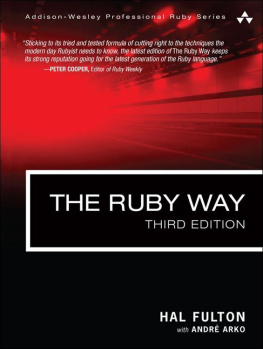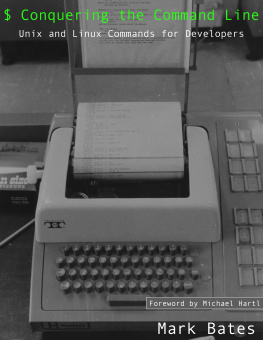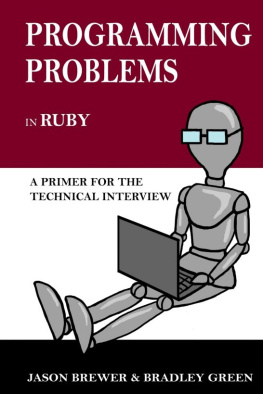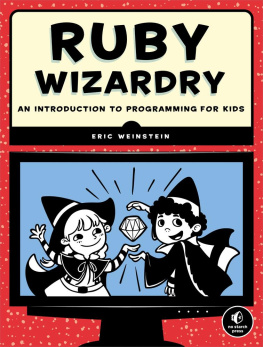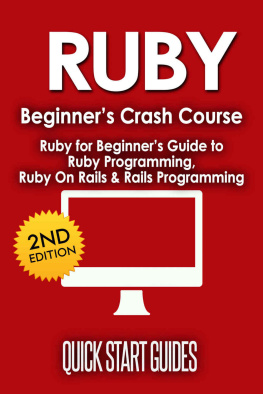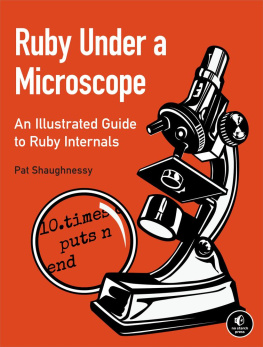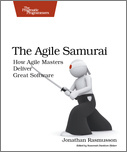Mark Bates - The Ruby Way Solutions and Techniques in Ruby Programming
Here you can read online Mark Bates - The Ruby Way Solutions and Techniques in Ruby Programming full text of the book (entire story) in english for free. Download pdf and epub, get meaning, cover and reviews about this ebook. year: 2015, publisher: Addisоn-Wеsley Profеssional, genre: Computer. Description of the work, (preface) as well as reviews are available. Best literature library LitArk.com created for fans of good reading and offers a wide selection of genres:
Romance novel
Science fiction
Adventure
Detective
Science
History
Home and family
Prose
Art
Politics
Computer
Non-fiction
Religion
Business
Children
Humor
Choose a favorite category and find really read worthwhile books. Enjoy immersion in the world of imagination, feel the emotions of the characters or learn something new for yourself, make an fascinating discovery.
- Book:The Ruby Way Solutions and Techniques in Ruby Programming
- Author:
- Publisher:Addisоn-Wеsley Profеssional
- Genre:
- Year:2015
- Rating:4 / 5
- Favourites:Add to favourites
- Your mark:
- 80
- 1
- 2
- 3
- 4
- 5
The Ruby Way Solutions and Techniques in Ruby Programming: summary, description and annotation
We offer to read an annotation, description, summary or preface (depends on what the author of the book "The Ruby Way Solutions and Techniques in Ruby Programming" wrote himself). If you haven't found the necessary information about the book — write in the comments, we will try to find it.
The Ruby Way Solutions and Techniques in Ruby Programming — read online for free the complete book (whole text) full work
Below is the text of the book, divided by pages. System saving the place of the last page read, allows you to conveniently read the book "The Ruby Way Solutions and Techniques in Ruby Programming" online for free, without having to search again every time where you left off. Put a bookmark, and you can go to the page where you finished reading at any time.
Font size:
Interval:
Bookmark:
ePUB is an open, industry-standard format for eBooks. However, support of ePUB and its many features varies across reading devices and applications. Use your device or app settings to customize the presentation to your liking. Settings that you can customize often include font, font size, single or double column, landscape or portrait mode, and figures that you can click or tap to enlarge. For additional information about the settings and features on your reading device or app, visit the device manufacturers Web site.
Many titles include programming code or configuration examples. To optimize the presentation of these elements, view the eBook in single-column, landscape mode and adjust the font size to the smallest setting. In addition to presenting code and configurations in the reflowable text format, we have included images of the code that mimic the presentation found in the print book; therefore, where the reflowable format may compromise the presentation of the code listing, you will see a Click here to view code image link. Click the link to view the print-fidelity code image. To return to the previous page viewed, click the Back button on your device or app.
Third Edition
Hal Fulton
with Andr Arko

Upper Saddle River, NJ Boston Indianapolis San Francisco
New York Toronto Montreal London Munich Paris Madrid
Cape Town Sydney Tokyo Singapore Mexico City
Many of the designations used by manufacturers and sellers to distinguish their products are claimed as trademarks. Where those designations appear in this book, and the publisher was aware of a trademark claim, the designations have been printed with initial capital letters or in all capitals.
The authors and publisher have taken care in the preparation of this book, but make no expressed or implied warranty of any kind and assume no responsibility for errors or omissions. No liability is assumed for incidental or consequential damages in connection with or arising out of the use of the information or programs contained herein.
For information about buying this title in bulk quantities, or for special sales opportunities (which may include electronic versions; custom cover designs; and content particular to your business, training goals, marketing focus, or branding interests), please contact our corporate sales department at or (800) 382-3419.
For government sales inquiries, please contact .
For questions about sales outside the U.S., please contact .
Visit us on the Web: informit.com/aw
Library of Congress Control Number: 2014945504
Copyright 2015 Pearson Education, Inc.
All rights reserved. Printed in the United States of America. This publication is protected by copyright, and permission must be obtained from the publisher prior to any prohibited reproduction, storage in a retrieval system, or transmission in any form or by any means, electronic, mechanical, photocopying, recording, or likewise. To obtain permission to use material from this work, please submit a written request to Pearson Education, Inc., Permissions Department, One Lake Street, Upper Saddle River, New Jersey 07458, or you may fax your request to (201) 236-3290.
ISBN-13: 978-0-321-71463-3
ISBN-10: 0-321-71463-6
Text printed in the United States on recycled paper at RR Donnelley in Crawfordsville, Indiana
First printing: March 2015
Editor-in-Chief
Mark Taub
Executive Editor
Debra Williams-Cauley
Development Editor
Songlin Qiu
Managing Editor
Kristy Hart
Project Editor
Andy Beaster
Copy Editor
Bart Reed
Indexer
Ken Johnson
Proofreader
Sarah Kearns
Cover Designer
Chuti Prasertsith
Senior Compositor
Gloria Schurick
Sticking to its tried and tested formula of cutting right to the techniques the modern day Rubyist needs to know, the latest edition of The Ruby Way keeps its strong reputation going for the latest generation of the Ruby language.
Peter Cooper
Editor of Ruby Weekly
The authors excellent work and meticulous attention to detail continues in this latest update; this book remains an outstanding reference for the beginning Ruby programmeras well as the seasoned developer who needs a quick refresh on Ruby. Highly recommended for anyone interested in Ruby programming.
Kelvin Meeks
Enterprise Architect
Among other things, this book excels at explaining metaprogramming, one of the most interesting aspects of Ruby. Many of the early ideas for Rails were inspired by the first edition, especially what is now . It puts you on a rollercoaster ride between How could I use this? and This is so cool! Once you get on that rollercoaster, theres no turning back.
David Heinemeier Hansson
Creator of Ruby on Rails,
Founder at Basecamp
The appearance of the second edition of this classic book is an exciting event for Rubyistsand for lovers of superb technical writing in general. Hal Fulton brings a lively erudition and an engaging, lucid style to bear on a thorough and meticulously exact exposition of Ruby. You palpably feel the presence of a teacher who knows a tremendous amount and really wants to help you know it too.
David Alan Black
Author of The Well-Grounded Rubyist
This is an excellent resource for gaining insight into how and why Ruby works. As someone who has worked with Ruby for several years, I still found it full of new tricks and techniques. Its accessible both as a straight read and as a reference that one can dip into and learn something new.
Chet Hendrickson
Agile software pioneer
Rubys a wonderful languagebut sometimes you just want to get something done. Hals book gives you the solution and teaches a good bit about why that solution is good Ruby.
Martin Fowler
Chief Scientist, ThoughtWorks
Author of Patterns of Enterprise
Application Architecture
To my parents, without whom I would not be possible
Hal
Yesterday I was reading an article about geek fashion in Wired.com. According to it, wearing a Rubyconf 2012 t-shirt these days signals to people: I work for Oracle.
Wow. How far weve come in the last 10 years!
For quite some time, using Ruby set you apart from the mainstream. Now it seems we are the mainstream. And what a long, strange journey it has been to get there.
Ruby adoption took a long time by todays standards. I read this book in 2005, and at that point, the first edition was over four years old. Ruby had just begun its second wave of adoption thanks to DHH and the start of Rails mania. It seemed like there might be a couple hundred people in the entire (English-speaking) world that used Ruby. Amazingly, at that point, the first edition of this book was already four years old. Thats how ahead of its time it was.
This new edition keeps the writing style that has made the book such a hit with experienced programmers over the years. The long first chapter covers fundamental basics of object-orientation and the Ruby language. Its a must read for anyone new to the language. But it does so in concise, fast-moving narrative that assumes you already know how to create software.
Font size:
Interval:
Bookmark:
Similar books «The Ruby Way Solutions and Techniques in Ruby Programming»
Look at similar books to The Ruby Way Solutions and Techniques in Ruby Programming. We have selected literature similar in name and meaning in the hope of providing readers with more options to find new, interesting, not yet read works.
Discussion, reviews of the book The Ruby Way Solutions and Techniques in Ruby Programming and just readers' own opinions. Leave your comments, write what you think about the work, its meaning or the main characters. Specify what exactly you liked and what you didn't like, and why you think so.

